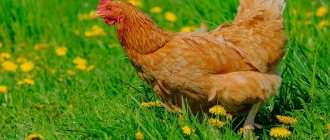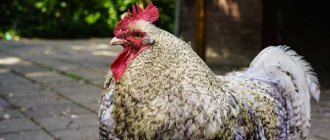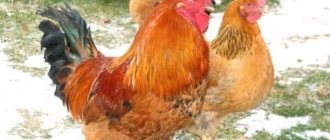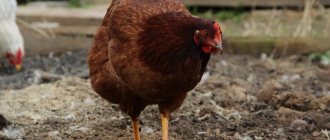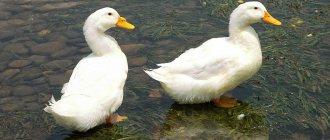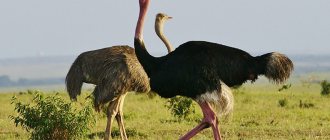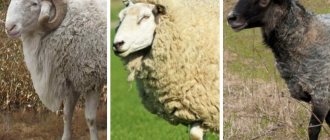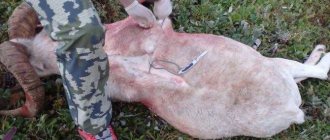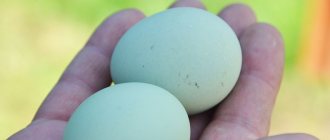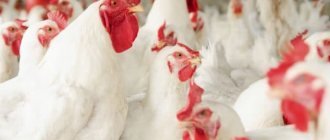Laying hens are found in many courtyards of villages and villages. They are quite unpretentious and delight their owners with homemade eggs for almost a whole year.
However, before you get yourself such a bird, you need to find out which breed of chickens is the most egg-producing for home breeding.
To obtain food eggs, you should choose representatives of the egg direction. The peculiarity of such chickens is their small size, light bones, and most importantly, large and frequent eggs.
In our rating there are also representatives of the meat and egg direction, since they also have high egg production. The list is presented in alphabetical order with the main characteristics of each breed.
IMPORTANT: the peak of egg production occurs in the first 1-3 years of life, after which this figure gradually decreases.
PS. The article describes 10 purebred breeds and 2 crosses (Dominant and Loman Brown) - take this into account, dear readers.
Australorp
These chickens were bred in Australia, where they were very popular in the early and mid-19th century and were found on almost all farms. Black Orpingtons were used as the basis for their production.
Characteristic:
- Egg production (per year): 180-220 pcs. (55-65 g).
- Testicle color: brown.
- Laying hen weight: 2.8 kg.
- When they start laying eggs: 120-150 days.
Chickens have a high egg production. The color is black, in the sun it casts green. Blue and white/gray Australorps are also found. The comb is leaf-shaped, the earlobes are bright red. The bird rushes even in winter, but for this it needs additional lighting.
California Grays
According to the description, this ash-blue breed of chickens was bred on the basis of Plymouth Rocks and is similar in appearance. The birds' plumage alternates between gray and white feathers. Their body is elongated, legs are of medium length and strong. The wings are well developed. The tail is carried high in relation to the back. The weight of adults is 2-3 kg. Egg productivity – 200 pieces.
Ameraucana
The breed was created in 1976 by the American Poultry Association. To obtain them, tailless representatives of the Araucana breed were crossed with local egg-laying chickens. The result is a productive layer that produces blue eggs.
Peculiarities:
- Egg production (per year): 210-260 pcs. (60-65 g).
- Testicle color: blue.
- Laying hen weight: 2.6 kg.
- When they start laying eggs: 180-240 days.
A characteristic feature of the Ameraucana is the presence of sideburns and a goatee. The comb has the appearance of a pod; in chickens it is almost invisible. The tail is well feathered, unlike the related Araucana breed. Colors may vary.
INTERESTING! The color of the egg shell is necessarily blue. If it is pink, beige or white, the chickens are not Ameraucanas.
Amrox
The breed was developed in 1848 from Barred Rock chickens in America (Massachusetts). To obtain it, striped Plymouth rocks were used. Amroks are an autosex breed, since chickens can be distinguished by sex on the first day due to a characteristic spot on the head.
Characteristic:
- Egg production (per year): 190-210 pcs. (55-65 g).
- Testicle color: light brown.
- Laying hen weight: 2.4 kg.
- When they start laying eggs: 180-240 days.
The breed is universal. Chickens lay eggs well at home, but the eggs are not very large. Amroks are unpretentious to weather conditions and tolerate cold well. The color is striped black and gray. The leaf-shaped comb is bright red.
Common diseases
The Pushkin breed has good immunity. The cause of most diseases is improper care. The development of infectious diseases will be prevented by vaccination.
Common diseases of Pushkin chickens and their main symptoms:
| Disease | Description | Symptoms |
| Newcastle disease | The disease is infectious and incurable | The comb becomes a dark burgundy shade. Sick individuals also experience shortness of breath and bloody diarrhea. |
| Bird pox | The disease is contagious, transmitted through food, drink and sick birds | Yellowish pockmarks on the ridge that turn brown over time |
| Bronchopneumonia | The disease develops with hypothermia. Most often affects chicks no more than a month old. | Mucus production, wheezing, lack of appetite |
| Marek's disease | This infectious disease is incurable | Swollen joints, curled fingers |
| Avitaminosis | The disease develops due to a deficiency of vitamins in the bird’s body. | Feather loss, emaciation, development of conjunctivitis |
Treatment
Treatment of non-infectious diseases can be medicinal and prescribed by a veterinarian. Broad-spectrum antibiotics are most often used.
Treatment of vitamin deficiency involves enriching the diet of a sick chicken with vegetables, fresh herbs and mineral supplements.
Prevention
Infectious diseases usually affect young animals. For this reason, it is not recommended to place adults older than one year and young chickens in the same house.
Basic preventive measures:
- regular cleaning and disinfection of the chicken coop;
- periodic ventilation of the room;
- creating a balanced diet;
- timely vaccination.
Vaccination
Only timely vaccination will help prevent the development of viral and infectious diseases. It is recommended to entrust the choice of a suitable drug to a veterinarian.
Approximate vaccination table for Pushkin chickens:
| Disease | Recommended age of the bird in days |
| Salmonella | 1-2 |
| Marek's disease | 1-3 |
| Coccidiosis | 5-7 |
| Gumboro disease | 20-25 |
| Infectious bronchitis | 30 |
| Newcastle disease | 35 |
| Avian encephalomyelitis | 90 |
Hamburg
An ancient breed that originates in Holland, but it was recognized in the German city of Hamburg. Local chickens were used to obtain it. They are often kept as ornamental, but at the same time they show good egg production.
Peculiarities:
- Egg production (per year): 175-250 pcs. (45-55 g).
- Testicle color: white.
- Laying hen weight: 1.8 kg.
- When they start laying eggs: 120-150 days.
Small chickens with an attractive appearance. They need a large enclosure with a closed top, as they fly well. The colors are divided into two groups: speckled (golden, flesh to tan, silver and lemon with black speckles) and edged (golden and silver).
INTERESTING! There are also black and white chickens. The comb is pink, the lobes are white.
Dominant
Numerous crosses bred in the Czech Republic. Includes several varieties of chickens that differ in color, egg shell color and direction of productivity.
Characteristic:
- Egg production (per year): 280-320 pcs. (60-70 g).
- Color of testicles: brown in different shades, cream, blue, green.
- Laying hen weight: 2 kg.
- When they start laying eggs: 120-150 days.
Farmers more often keep grey-speckled, black, blue and silver dominants on their farms. Dominant hens begin to lay eggs early and the eggs are large. The peculiarity of the cross is its demands on the composition of the feed mixture. With a lack of protein and calcium, egg production decreases.
IMPORTANT: when breeding, the egg production of young animals will be much lower, since this is a typical cross.
Zagorskaya salmon
A domestic breed that was bred in 1955 at the Zagorsk Poultry Institute. It contains the blood of Yurlovsky vocal and Russian white chickens. Representatives of the New Hampshire and Rhode Island breeds were also used.
Peculiarities:
- Egg production (per year): 190-210 pcs. (65-75 g).
- Testicle color: creamy brown.
- Laying hen weight: 2.5 kg.
- When they start laying eggs: 150-160 days.
A bird with a calm character that gets along well with other animals. Unpretentious to diet and ambient temperature. The color of the chickens is light beige, the feathers on the tail and wings are darker. The comb is leaf-shaped.
Classification
All breeds of chickens are divided according to the following characteristics:
- Direction of use.
- Weight and dimensions.
- Egg production.
- Color, comb shape, color and size of eggs, etc.
According to the direction of human use, chicken breeds are divided into the following types:
- egg direction;
- meat breeds of chickens;
- meat and egg poultry;
- decorative - dwarf and with a very unusual appearance: silk chickens, silver, blue breed, bantam and others;
- vocal;
- fighting breeds of chickens - they are bred mainly in Asia.
Sussex chickens
The most famous chicken breeds by area:
- Egg: Russian white, leghorn, brekel.
- Meat: Cochin, Brahma, Cornish, Faverolles, Sussex chickens.
- Universal: Plymouth Rock, Forwerk, New Hampshire, Faverolles, Rhode Island, Moscow, Amrox, Kuchinskaya, Moscow White, Kotlyarevskaya breed of chickens, Orpington, Leningrad and Dutch calico, Livenskaya breed of chickens.
- Decorative and unusual: bantam, Wyandotte, black Dutch white-crest, paduan, seabright, curly, silky chickens, Andalusian.
- Vociferous: Yurlovskaya vociferous.
- Fighting: Azil, Fighting English, Kulangi, Moscow Fighting, Indian black and blue, Malay.
Azil fighting chickens
Kuchin anniversary
The breed was obtained by Soviet breeders. It was officially recognized in 1990. To breed it, the best representatives of the Plymouth Rock, Rhode Island, Liven and New Hampshire breeds were used.
Characteristic:
- Egg production (per year): 210-260 pcs. (50-65 g).
- Testicular color: red-brown.
- Laying hen weight: 2.8 kg.
- When they start laying eggs: 180-200 days.
A strong, hardy and unpretentious bird. Young animals adapt well to different living conditions. In winter, laying hens continue to produce eggs even at temperatures around +5 degrees. Golden calico color of varying saturation. Leaf-shaped scallop.
Leghorn
The homeland of these chickens is Italy. They gained popularity in the 19th century. The best breeders took part in the breeding, and each of them contributed to the development of the breed. They are actively used to produce highly productive chicken crosses.
Peculiarities:
- Egg production (per year): 260-300 pcs. (55-60 g).
- Testicle color: white.
- Laying hen weight: 1.75 kg.
- When they start laying eggs: 120-150 days.
A small but very productive bird. Laying hens produce about 300 eggs per year and begin to lay eggs by 4-5 months. Leghorns are active and restless chickens. The standard includes two colors: white and brown.
INTERESTING! A characteristic feature of the breed is a large leaf-shaped comb hanging on its side.
Loman Brown
This cross was obtained by German breeders in 1970. Information about the breeds that were used to produce these chickens is still kept secret. On the first day, chickens differ in gender (cockerels are light, and hens are darker).
Characteristic:
- Egg production (per year): 310-320 pcs. (60-65 g).
- Testicle color: light brown.
- Laying hen weight: 1.8 kg.
- When they start laying eggs: 120-150 days.
One of the most popular chickens. However, they have a peculiarity - productivity drops sharply after 2 years of life. At home, it is impossible to obtain young animals with the same egg production rates. The color is brownish-red, the tail has a lighter shade.
How to choose the right breed?
Chickens of different colors
Which breed of black or blue chickens should you choose? You need to resolve this issue based on your capabilities and preferences. It would be more correct to evaluate all the necessary factors, only then make a choice.
Egg production
If you need a chicken for eggs, you should consider the breeds of laying hens and compare the number of eggs they can produce in a year.
Popular breeds:
- Avicolor - from 250 eggs per year;
- amrox – from 200 eggs per year;
- Welsumer - from 150 eggs per year;
- maran - up to 150 eggs per year;
- Oryol Russian - up to 150 eggs per year.
In order to have your own eggs from laying hens all year round, you should choose purebred chickens or crosses with high productivity.
Hen hatching eggs
How to choose?
To choose a bird that will lay eggs, you need to pay attention to some criteria.
What to pay attention to:
- buy birds in the spring, at the age of about five months - then their peak egg production will be in the summer. when there is long daylight;
- it is preferable to choose birds from farmers, they live in free conditions, therefore they are in good health (the main thing is to check the health of the individuals);
- the bird must be clean, well-groomed, with uniform plumage;
- It is better to discard an individual with dirty, stuck together feathers, this may be a sign of infection;
- the distance between the bones of the pubis should be from three to four centimeters;
- the individual’s belly should be soft, this will be evidence that it was fed moderately, not too much and not too little;
- the beak should close tightly and evenly;
- a healthy bird will not sneeze or have nasal discharge;
- the skin under the feathers should be pink, without wrinkled areas or sagging;
- do not buy chickens that show signs of both sexes - such birds will be unproductive.
Chickens at a poultry farm
It is better to choose laying hens of approximately the same age and weight, so that it is easier to care for them, and their egg production is approximately the same.
Pushkinskaya
The breed was obtained in the city of Pushkin, from where it took its name. It was approved only in 2008. There are two lines of this breed: selection from St. Petersburg and Sergiev Posad. They differ in color and appearance.
Peculiarities:
- Egg production (per year): 210-260 pcs. (70-75 g).
- Testicle color: white.
- Laying hen weight: 2.5 kg.
- When they start laying eggs: 120-150 days.
Pushkin chickens are the most suitable breed for private households. They are unpretentious and begin to lay eggs early. The egg is very large, weighing about 70-75 grams. Chickens are unpretentious to air temperature and diet.
IMPORTANT! The color of laying hens bred in St. Petersburg is variegated, black and white, with a pink comb. Chickens obtained in Sergiev Posad are darker, gray-black, with a leaf-shaped comb.
Russian white
In the first half of the 19th century, breeders began crossing Leghorns with various outbred chickens. After obtaining the first productive hybrids, they were bred “inside”. As a result of further work, Russian white chickens were obtained.
Characteristic:
- Egg production (per year): 200-235 pcs. (55-60 g).
- Testicle color: white.
- Laying hen weight: 1.75 kg.
- When they start laying eggs: 150-180 days.
A small bird whose weight does not exceed 1.8 kg. Chickens are unpretentious, but very active and need a lot of walking. The color must be snow-white. The comb is large and red, hanging slightly to the side (the breed adopted this feature from Leghorns).
Selection directions
Over many years of work in breeding technology, three main directions have been developed:
- Meat. Mainly used for cage keeping and rearing of broilers. But there are also purely farm breeds.
- Egg-laying. The main breeds were bred for large poultry farming complexes.
- Egg meat. The main farmed bird. In addition, there is also a direction for decorative birds.
Sussex
An English breed that was developed at the beginning of the 19th century. It was obtained by crossing representatives of the Brahma, Dorking and other breeds with outbred chickens. As a result of constant selection work, the egg production of Sussex laying hens has improved.
Peculiarities:
- Egg production (per year): 150-200 pcs. (55-65 g).
- Testicle color: yellow-brown.
- Laying hen weight: 2.8 kg.
- When they start laying eggs: 180-240 days.
The chickens are medium sized, friendly and calm. They get along well with other birds and are prone to incubation. The color is white, there is a characteristic rim of black feathers on the neck. The tail is dark. The scallop is red, leaf-shaped.
There are many breeds of chickens, but not all of them have high egg production. To keep on a private farm and obtain a large amount of eggs, it is better to choose a calm and peaceful bird of the egg type, unpretentious to the conditions of detention and diet.
Note: a well-designed menu is the key to high egg production of chickens.
Types of roosters by fighting style
Based on the fighting style, fighting cock breeds are conventionally divided into 4 types:
- Straight. When meeting, he immediately rushes at his opponent and hits him in the chest or head with a strong blow.
- Circular. He exchanges a couple of blows with his opponent, then turns around, begins to “circle” (run in a circle), after which he suddenly attacks the enemy again, and, without allowing the latter to come to his senses, runs away again. Thus, he exhausts his opponent, due to which he often wins.
- Sent. He doesn’t run in a circle, but intercepts his opponent in a straight line and hits him straight in the back of the head.
- Thievish. It is highly valued because it competently conducts battle tactics: it tries to remove its head from the blow, goes to its feet, hides under the enemy’s wing, thereby knocking the latter off the pace. He himself seizes the right moment and strikes.
Roosters of different breeds can be fighters from birth and fight using all tactics. Sometimes it seems that these versatile warriors, depending on the opponent's style, are considering which one to use in order to win.
A characteristic feature of the fighting breed of roosters is scanty plumage, which causes poor body heat retention. Therefore, it is recommended to keep such birds in a heated room. The key to caring for fighting cocks is a high protein diet.
